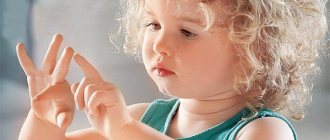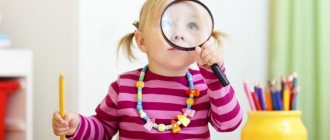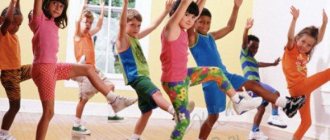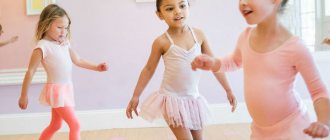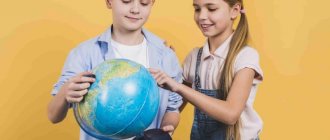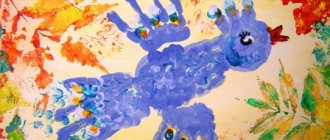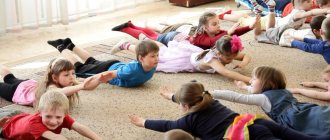Psycho-gymnastics in kindergarten. Card file of exercises part 4
Read the beginning here
Psycho-gymnastics in kindergarten. Card file of exercises part 1
Card file of exercises part 2
Card file of exercises part 3
Here we will look at some of the leading mechanisms of the influence of psycho-gymnastics on the child’s psyche .
1. In the process of mastering the technique of expressive movements, the child learns to recognize the corresponding feelings and emotional states of others, name them in words and respond adequately to them. The development of an emotional vocabulary, the ability to understand and express one’s feelings prevents the child from developing emotional problems and nervous tension.
2. In special sketches and games, children train their attention, memory, observation, endurance, and also master the useless component of the corresponding mental states (attention, concentration, relaxation, anger, fear). The ability, while playing, to mentally experience concentration or fear makes these states more controlled, more dependent on the child.
3. One of the leading mechanisms of the influence of psychogymnastics on the development of the emotional and personal sphere of preschool children is based on the psychotherapeutic relationship between play and art. Children are encouraged to display their emotional experiences in stories, drawings, and dramatizations. By portraying imaginary dangers and experiencing exaggerated fears, through satiety they are freed from the psycho-traumatic effect of emotional experiences. This mechanism of psychocorrection applies not only to fears, but also to anger, rage, disgust, jealousy, etc.
4. In the education of higher moral feelings, the mechanism of “getting used to the image” is of great importance. This, on the one hand, is an opportunity to be in the role of creatures that frighten the baby, as well as those people with whom he communicates. In this way, the child moves away from an egocentric position in perceiving the situation. On the other hand, playing the role of a positive hero who was not afraid, showed concern, and helped others, the baby receives positive feedback: they are grateful to him, they praise him, they are proud of him. Experiences of joy about “how good I am,” “how well I did,” changes the child’s self-esteem and has a much better effect on his behavior than reproaches and admonitions.
The plot of each lesson must include 2-3 exercises on emotions and emotional contact. These exercises are aimed at developing children’s abilities to understand, be aware of their own and other people’s emotions, express them correctly and fully experience them; their ultimate goal is precisely to master the skills of managing their emotional sphere.
Muscle relaxation exercises
Exercises help in a playful way to master techniques for releasing psycho-muscular tension. Self-relaxation is necessary for children with a very excited or overly sensitive nervous system, children who are characterized by fear, obsessive states and movements, hysterical reactions, stuttering, etc.
The cat is sleeping (3-4 years)
Children listen to the presenter and pretend to be a tired cat: they lie down on the floor, stretching, and begin to breathe evenly and calmly. The teacher approaches them, raises the hands (“paws”) of one and the other, but their hands fall like cotton wool.
Barbell (5-6 years)
A child lifts a “heavy barbell.” Then he throws it away and rests.
Balloon (ball) (5-6 years)
A girl or boy is chosen to play the role of the ball. First, the child imitates a deflated ball: legs are bent, arms and neck are relaxed, and the body is tilted forward. One of the children begins to inflate the ball with a pump. accompanying each portion of air with the sound “ssss”. Hearing the first sound “s-s-s”, the ball inhales air and straightens its legs at the knees, then straightens its torso, raises its head and arms, and puffs out its cheeks. The ball is inflated. Then it is lowered to the sound “sh-sh-sh”, the air comes out of it and the body returns to its previous state.
Children change roles.
Expression of peace and relaxation
These exercises allow you to relax muscles through mastering expressive movements and thus manage the child’s emotional state. Instilling calm is best achieved in group tasks, where all students together slow down their movements, whisper and freeze.
Snowflakes (3-4 years)
The breeze blew. Snowflake children spin to live music. And then the breeze dies down, the music slows down, the snowflakes barely move and finally fall to the ground (the children crouch, lower their arms, bow their heads as if they had fallen asleep). Everything is quiet.
Wind-up toys (4-5 years)
Children play with a wind-up toy and notice how its movement slows down when the wind-up ends. And then they themselves depict a clockwork chicken, a bunny, a train, etc. (gradually slow down their movements, stop, freeze).
Dream Fairy (5-6 years old)
Children sit on chairs standing in a circle at a sufficient distance. A lullaby sounds. A girl with a “magic wand” (sleep fairy) approaches one of the children and touches his shoulder with the wand, he falls asleep (tilts his head and closes his eyes). So she goes around all the children and quietly leaves.
Enchanted City (5-6 years)
Children listen to a fairy tale about an enchanted princess. Everyone chooses a pose and freezes. The host is trying to wake up the participants in the game. And only when he kisses the princess does everyone wake up.
Expression of a cheerful and joyful mood
Playful exercises in which children depict laughter, joy, and pleasure help create a warm atmosphere in the group, lift their spirits, and bring children emotionally closer to each other. These games are useful for children with psychomotor and emotional difficulties. They exclude healthy emotional arousal and distract from painful fantasies and experiences. The cheerful mood created by them has long-lasting durability.
Unexpected joy (4-5 years)
Mom came into the room where the children were playing. She smiled and said: “Children, finish your game. I managed to buy tickets to the circus. The show starts in 2 hours."
The children froze at first, and then began to dance around their mother.
Expressive movements: laughing, rubbing hands, clapping, dancing.
Cheerful friends (5-6 years old)
Children are divided into pairs. Each couple takes turns acting out such a scene. Two friends who haven't seen each other all summer finally meet in the yard. They shout joyfully, run up to each other, hug, jump for joy, laugh, dance or run around holding hands.
Expression of peace and satisfaction
These games help calm children, create a warm psychological atmosphere in the group, and evoke a feeling of affection for each other. They are recommended for use with aggressive, excitable children who often have conflicts with peers.
Delicious sweets (3-4 years)
One of the children is holding an imaginary box of candy. He treats the children one by one. The kids take one candy at a time, thank the owner, then unwrap the candy and put it in their mouth. The expression on their faces immediately shows that the food is delicious.
Facial expressions: chewing movements, smiling, expression of pleasure, satisfaction.
Golden drops (4-5 years)
It's warm raining. Bubbles dance in puddles. The sun came out from behind the cloud. The rain turned golden.
Children expose their faces and palms to the golden drops of warm summer rain.
Music plays during the sketch
Expressive movements: head thrown back, mouth half-open, eyes closed, facial muscles relaxed, shoulders down.
Flowerbed and gardener (5-6 years old)
Children choose the roles of flowers in the flowerbed. All the flowers withered because there was no rain. But finally the gardener came and watered the plants. They raised their heads, unfolded their petals and became extremely beautiful. Flowers smile gratefully at the gardener, admiring themselves and their neighbors in the flowerbed.
Expressive movements: squat down, lower your head and arms (the flower has withered), raise your head, straighten your torso, raise your arms (the flower has bloomed).
Facial expressions: eyes half-closed, muscles relaxed, satisfied smile.
The game can be continued, suggesting situations: the sun is warming - the sun is scorching, it’s hot - a light breeze has blown - the wind has become cold, the flowers are frozen - the gardener closed them from the wind...
The little engine from Romashkovo (5-6 years old)
Children imagine themselves as passengers of a wonderful cartoon train. The train stops in a strange meadow where many flowers grow. Passengers admire the sunset, listen to birdsong, collect daisies (lily of the valley, strawberries, dandelions, snowdrops, leaves), smell the bouquets, and smile happily.
Psycho-gymnastics with children of the middle group. Topic: “Becoming bear cubs”
Target:
- relieving psycho-emotional stress;
- training the muscles of the face and torso;
- development of voluntary attention and imagination.
• Children, let's play! A big bear came to visit us.
Show how big she is! (Children show by standing on their toes.) What are her children's names? (Bear cubs). Are the bear cubs small or large? (Little ones). Show how small they are. (Children squat.) How do bears walk? (Children waddle from side to side.)
• The cubs woke up, stretched, and smiled. (Children perform movements together with the leader). They began to do exercises: arms up, arms to the sides, arms forward, hands on the shoulders, hands on the waist, hands behind the head, hands behind the back. Stretch! And now you will make these movements only when I say the word “please.” There is no word “please” - no movement required.
• The cubs wanted to have breakfast. What do bear cubs like to eat? (Honey and raspberries. The bear cubs crawled on all fours to look for where their delicacy grows. (Children repeat the movements). They look around. (Turn their heads left and right). Hurray! We found raspberries! (Children imitate the bear cubs' breakfast).
• The cubs had some food and wanted to play.
– “Bumps” (an exercise for tensing and relaxing the arm muscles).
Mama bear “throws” cones to the cubs. They squeeze them forcefully in their paws. The cones are broken into small pieces. The cubs throw them to the sides and drop their paws along the body - the paws rest. Mom throws cones again. (2-3 times).
– “Game with a bee” (an exercise to tense and relax the leg muscles).
The mother bear invites the golden bee to play with her cubs. Children raise their knees, making houses. A bee flies under your knees. Mom says: “It’s flying!”, and the cubs straighten their legs together. (2-3 times).
- “Riding bicycles.” (leg muscle training).
Bear cubs love to ride bicycles. (Lying on their backs, children imitate riding bicycles).
– “Cold wind” (an exercise for tensing and relaxing the muscles of the torso).
The bear left. A cold north wind blew and made its way
take the cracks into the den. Blow as the wind blows (children repeat the movement).
The cubs are frozen. They are curled up into little balls, warming themselves. (The children shrink, showing how frozen they are.) It got hot - the cubs turned around. The north wind blew again. (2-3 times).
- “Scarves.” Mom came and distributed scarves to the cubs so that they would not freeze. The cubs turned their heads from side to side. Okay, it's warm!
– “The bee interferes with sleep” (play of facial muscles).
The bee flew into the den again. She decided to sit on her tongue, but the cubs clenched their teeth, folded their lips into a tube and began to twist them in different directions. Sat on the forehead, nose, cheeks. (Children wrinkle their forehead, nose, cheeks).
The mother bear came and turned on the light - the cubs closed their eyes from the bright light. Mom turned off the light - the cubs stopped squinting. (Children repeat the movements).
• The day has come to an end. It's time to sleep. Mama bear sang a lullaby to her cubs. (Children lie down on the carpet, close their eyes and “fall asleep” to the music for 3-4 minutes).
The music stops, the children open their eyes and stretch. They turn back into boys and girls.
What is psychogymnastics?
Let's try to figure out what psycho-gymnastics for preschoolers is and what it gives to the child.
So, psycho-gymnastics means certain special games and exercises that develop and correct the psychological component of the child. The language of onomatopoeia and interjections, conveying various emotional states, teaches the child goodwill and openness. The use of such figurative quatrains develops creativity, imagination, initiative, courage, and certain knowledge is consolidated. In addition, in the process of using various psycho-gymnastics, children find an outlet for muscular and mental energy.
Psycho-gymnastics in kindergarten is aimed at relieving tension and maintaining inner peace and confidence, freeing oneself from fears, improving activity, and developing the ability to express one’s feelings and emotions in words.
